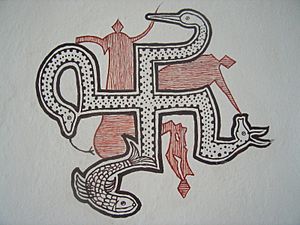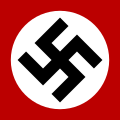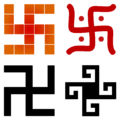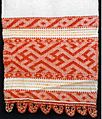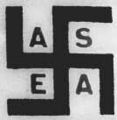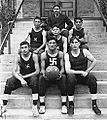Swastika facts for kids
The Swastika is a symbol that looks like a cross with its arms bent at right angles. It can face either left or right. For thousands of years, it has been an important religious symbol in places like Hinduism, Buddhism, and Jainism.
However, in the 1920s, a symbol very similar to the Swastika, called the Hakenkreuz, became the main symbol for the Nazi party in the Western world. This connection made the symbol very controversial.
Contents
Ancient Meanings of the Swastika
The Swastika is a very old and sacred symbol in Hinduism, Buddhism, and Jainism. It is also a sign of spiritual purity. In the ancient Sanskrit language, the word "swastika" meant luck or well-being.
You can find this symbol in many old cultures around the world. It has been seen on Byzantine buildings, Ancient Greek coinage, and even in Native American burial sites. For a long time, it was a symbol of good fortune and positive things.
The Swastika and the Nazis
During the 20th century, Adolf Hitler and the Nazi Party in Germany adopted a symbol called the Hakenkreuz. This symbol looked very much like the traditional Swastika. Hitler chose it as the main symbol for his political party.
Even before Hitler joined, some members of the German Workers Party already wore armbands with the Hakenkreuz. Hitler later decided on the famous red, white, and black colors for the Nazi flag, which featured this symbol. From 1935 to 1945, the Hakenkreuz was used on the German flag.
Because of its strong connection to the Nazis and their terrible actions during World War II, the Hakenkreuz became a symbol of hate. Many people now associate it with the Nazi's war crimes and their cruel beliefs.
Gallery of Swastika Symbols
-
The Nazi 'Hakenkreuz', which was often tilted. Adolf Hitler used it as the main symbol for National Socialism.
Images for kids
-
An Ashanti weight from Africa.
-
The Chilocco Indian Agricultural School basketball team in 1909.
See also
 In Spanish: Esvástica para niños
In Spanish: Esvástica para niños


